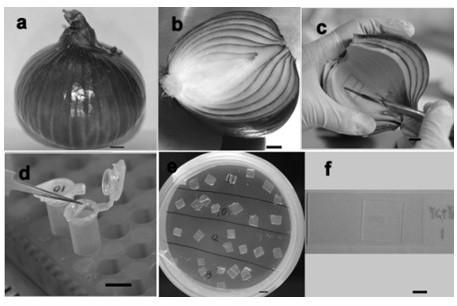A method for the establishment of a high-efficiency onion transient expression system mediated by Agrobacterium
An Agrobacterium-mediated and transient expression technology, applied in the field of plant genetic engineering, can solve the problem of low transformation efficiency, achieve accurate subcellular localization research, improve transformation efficiency, and achieve high transformation efficiency
- Summary
- Abstract
- Description
- Claims
- Application Information
AI Technical Summary
Problems solved by technology
Method used
Image
Examples
example 1
[0035] Optimization of Agrobacterium-mediated Subcellular Localization System of Onion Epidermal Cells
[0036](1) Select the onion bulbs that grow vigorously and have strong vitality, and remove the outermost 1-2 layers of scale leaves ( image 3 a), soak the onion bulbs in 70-75% ethanol for 10 minutes for disinfection, then wash the bulbs 3-5 times with sterile water in an ultra-clean workbench, and cut open the onion bulbs longitudinally with a sterile scalpel ( image 3 b) Take the thicker scale leaves in the middle layer, and use a scalpel to lightly draw about 1cm on the inner epidermis (concave surface) of these scale leaves 2 A number of cross squares, tear off the inner skin of these onions ( image 3 c);
[0037] (2) Using GFP as a reporter gene, optimize the transformation system. The GFP reporter gene was connected into the pCAMBIA3300 vector to construct the expression vector pCAMBIA3300-ubi-gfp binary expression vector ( figure 1 ). The vector was introduce...
Embodiment 2
[0048] Application of Agrobacterium-mediated transformation of onion epidermal cells to the study of protein subcellular localization
[0049] (1) Select the onion bulbs that grow vigorously and have strong vitality, and remove the outermost 1-2 layers of scale leaves ( image 3 a), soak the onion bulbs in 70-75% ethanol for 10 minutes for disinfection, then wash the bulbs 3-5 times with sterile water in the ultra-clean workbench, and cut the onion bulbs longitudinally with a sterile scalpel ( image 3 b) Take the thicker scale leaves in the middle layer, and use a scalpel to lightly draw about 1cm on the inner epidermis (concave surface) of these scale leaves 2 A number of cross squares, tear off the inner skin of these onions ( image 3 c);
[0050] (2) Using mCherry as the reporter gene, CWIN10B was connected into the pCAMBIA1300-mCherry vector to construct the expression vector pCAMBIA1300-CWIN10B-mCherry binary expression vector ( figure 1 ). The vector was introduced...
Embodiment 3
[0054] Agrobacterium-mediated transformation of onion epidermal cells applied to the study of protein-protein interactions
[0055] (1) Select the onion bulbs that grow vigorously and have strong vitality, and remove the outermost 1-2 layers of scale leaves ( image 3 a), soak the onion bulbs in 70-75% ethanol for 10 minutes for disinfection, then wash the bulbs 3-5 times with sterile water in the ultra-clean workbench, and cut the onion bulbs longitudinally with a sterile scalpel ( image 3 b) Take the thicker scale leaves in the middle layer, and use a scalpel to lightly draw about 1cm on the inner epidermis (concave surface) of these scale leaves 2 A number of cross squares, tear off the inner skin of these onions ( image 3 c);
[0056] (2) Connect CYCH and CDKD; 2 into pSPYNE-YCHA and pSPYNE-YNEE vectors respectively to form pSPYNE-CYCH-YCHA / CDKD; 2-YNEE vectors, pSPYNE-YCHA and pSPYNE-YNEE empty loads as negative controls ( figure 2 ). All vectors were introduced in...
PUM
| Property | Measurement | Unit |
|---|---|---|
| conversion efficiency | aaaaa | aaaaa |
Abstract
Description
Claims
Application Information
 Login to View More
Login to View More - R&D
- Intellectual Property
- Life Sciences
- Materials
- Tech Scout
- Unparalleled Data Quality
- Higher Quality Content
- 60% Fewer Hallucinations
Browse by: Latest US Patents, China's latest patents, Technical Efficacy Thesaurus, Application Domain, Technology Topic, Popular Technical Reports.
© 2025 PatSnap. All rights reserved.Legal|Privacy policy|Modern Slavery Act Transparency Statement|Sitemap|About US| Contact US: help@patsnap.com



